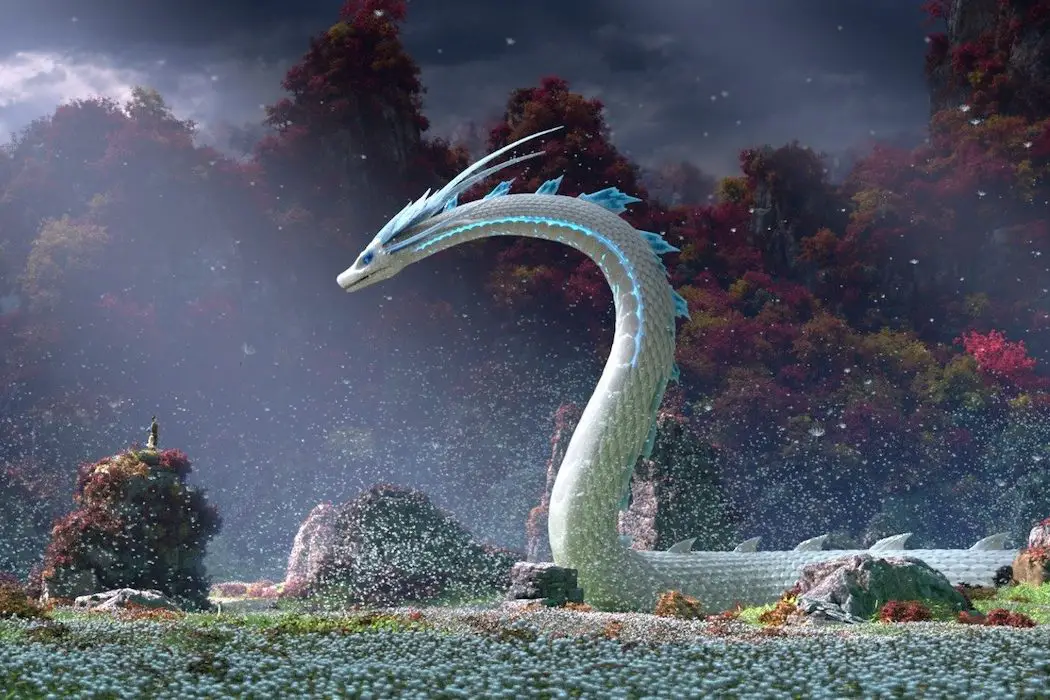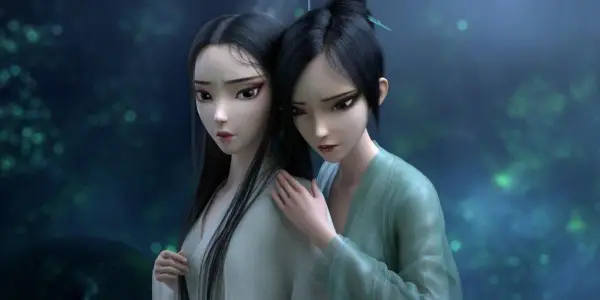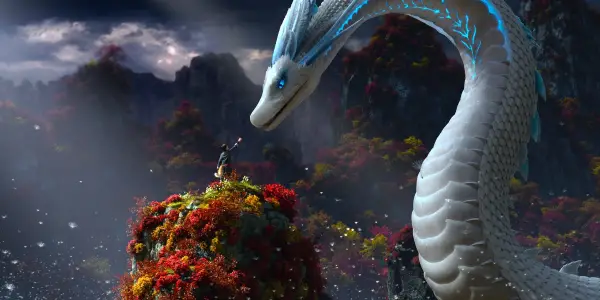WHITE SNAKE 白蛇:緣起: The Classic Myth + A Mesh Of Hollywood Ideas

Kevin L. Lee is an Asian-American critic, producer, screenwriter and…
The legend of the White Snake is one of China’s most enduring folktales, alongside stories of the Monkey King. Like all myths, the white snake’s story takes on multiple forms and variations through countless adaptations.
This latest 2019 release of White Snake seems to be an attempt to bring in a new generation of fans. Unlike previous iterations, which are mainly romantic dramas, this one adds in a whole fantasy action plotline, with enough magical objects and spells to rival Harry Potter and Spirited Away. The plus side is the film is remarkably creative. The downside is it ends up being a mesh of many other fantasy storylines that you’ve seen before.
Passable Romance and a Lot of Plot
The main drawback of White Snake is it’s trying to be two movies at once. On one end, you have the classic romance story. For newcomers, the general gist is a white snake demon, which can take the form of a woman, falls in love with a man. Think of it as a mythological Romeo and Juliet, where the couple cannot be together because one is a demon and one is a human, and so their love disrupts the world’s natural balance.
Fighting alongside the white snake is the green snake, who in this iteration is her younger sister (past iterations include an apprentice). The monk, who in the myth combats the white snake and prevents her from being with a human, is nowhere to be found here.

Instead, White Snake’s plot is about a medieval general who is attempting to achieve immortality by absorbing the energy of all snake demons, thus starting an ancient war between humans and demons. Rightfully ridiculous, yes. The issue here is not so much of whether I care about the plot. The problem is the plot takes center stage of the film; characters go places and make choices because they advance the plot, instead of advancing character depth and romance.
The result is a romantic storyline that becomes a passable subplot. The dialogue feels forced at best, resorting to obnoxious Asian drama clichés like the eventual couple accidentally touching hands when they first meet. Like most movies with romances, I rarely get behind the part where the characters slowly fall in love. But once the love is established, the part where the couple is pulled apart by fate is always interesting to watch. It’s just unfortunate to see the emotional core of this folktale muddled by a fantasy-action plot.
Crisp Animation, Fluid Cinematography, and a Lot of Creativity
If there’s one reason to see White Snake, it’s to see how far Chinese animation has come. With my previous review on a Chinese animated film being Ne Zha, White Snake continues to show that Asian filmmakers know how to direct action.
The “camera” in this film swoops around in between fights to give a stylistic sense of choreography and scale. Though the characters look a bit weightless at times, the animation is full of color and carries a sense of well-directed cinematography.

As for the fantasy stuff, characters will cast spells and suddenly a giant crane made of paper appears. A flirtatious fox demon changes between fox and human by simply twisting her head around like from The Exorcist. This film is definitely “out there” in terms of creativity and world-building. Half the time, the script doesn’t explain these images to the audiences; you just have to take them in. Certain locations and objects resemble Ollivander’s shop in Harry Potter or the weird creature servants of Yubaba in Spirited Away.
White Snake is full of bizarre imagery that you normally would not see from Hollywood, and for that reason, it’s worth checking out.
White Snake: Conclusion
The 2019 White Snake is a messy but ambitious mix of the original Chinese myth with tons of visual queues and tropes found in Hollywood films. Like I’ve said before, the Chinese movie industry is exceptionally good at borrowing elements from Hollywood. The white snake and green snake’s human forms are both drawn like a Chinese version of Queen Elsa in Frozen. The general casts spells by performing Naruto hand signs.
Like Ne Zha, White Snake is concerned about bringing in a new generation of fans. Both films take the myths and spin a fantasy action plot arc out of them to make their stories more entertaining and engaging, and both films have mid-credits scenes that tease a sequel.
The difference is while Ne Zha is already a story about a demon child who has fought many battles and defied his destiny, White Snake is a romance at heart that was stretched and mixed into an action epic. The film’s ideas don’t work all the time, but it is fun to see the filmmakers try.
Did you see White Snake? What did you think of the film? Share below!
White Snake was released in limited theaters in the US on November 15, 2019. For all international release dates, click here.
Does content like this matter to you?
Become a Member and support film journalism. Unlock access to all of Film Inquiry`s great articles. Join a community of like-minded readers who are passionate about cinema - get access to our private members Network, give back to independent filmmakers, and more.
Kevin L. Lee is an Asian-American critic, producer, screenwriter and director based in New York City. A champion of the creative process, Kevin has consulted, written, and produced several short films from development to principal photography to festival premiere. He has over 10 years of marketing and writing experience in film criticism and journalism, ranging from blockbusters to foreign indie films, and has developed a reputation of being “an omnivore of cinema.” He recently finished his MFA in film producing at Columbia University and is currently working in film and TV development for production companies.












